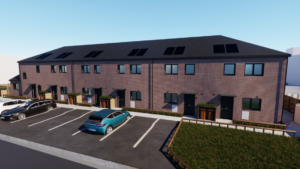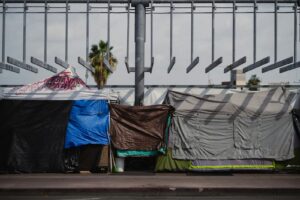Creating a community-controlled economy in Buffalo, New York
 For decades, corporations and governments had been taking more out of Buffalo than they were putting in. Now a radical vision for a community-controlled economy is taking shape.
For decades, corporations and governments had been taking more out of Buffalo than they were putting in. Now a radical vision for a community-controlled economy is taking shape.
Buffalo – the second largest city in the state of New York – has seen its fair share of hardship; dealing with significant population loss over the last 50 years; coping with ill-advised community development decisions during the urban renewal wave that swept across the region in the 70s; severe environmental issues due to the industrial legacy that put the city on the map.
But there’s hope in Buffalo; a real and tangible hope that is undeniable. Grassroots organizations like Push Buffalo are leading the charge, campaigning against empty housing, creating green jobs and creating a replicable model of grassroots neighbourhood organising and redevelopment.
People United for Sustainable Housing – or Push Buffalo – was founded back in 2005 by two west side community organisers who wanted to take a stand against the blight, poverty and joblessness so present in this part of town. Almost ten years later, the organisation has a staff of 35 and a membership roster of 300 west side residents who participate in direct actions around issues related to energy democracy, job creation, and empty housing.
Push strives to serve as a community anchor institution that reaches neighbuorhood residents through Alinsky-style base-building and community organising to gain control of resources related to energy and housing, while simultaneously incubating community-based social enterprises in the green construction and storm water management sectors
Fighting back against government housing speculation
Since its founding, Push Buffalo has worked with residents of the city’s west side to bring resources back into the neighbourhood. For decades, corporations and governments took more out of the west side than they put in.
The consequences of this neglect and exploitation were similar to those found in urban neighbourhoods across the country — deteriorating housing, hundreds of vacant lots and fewer and fewer jobs for local residents.
Push’s vision started with the idea that a grassroots movement based in the neighborhood could grow a thriving local economy, expand the community’s power and create positive cycles of success.
 West side residents did not wait long to show what they could accomplish with their organised power. From 2005 to 2006 neighbourhood leaders and Push organisers launched a militant campaign targeting a New York state housing agency that was using its control of vacant houses and lots in Buffalo to speculate on Wall Street.
West side residents did not wait long to show what they could accomplish with their organised power. From 2005 to 2006 neighbourhood leaders and Push organisers launched a militant campaign targeting a New York state housing agency that was using its control of vacant houses and lots in Buffalo to speculate on Wall Street.
Buildings that posed major economic, environmental, and public safety problems for west side residents had become chips in a high-stakes financial game designed to benefit wealthy investors. It was precisely this kind of reckless and exploitative activity that would soon lead to the global financial crash of 2008 and the great recession.
After a direct action campaign in which Push members boarded up hundreds of the state-controlled vacant homes with large stenciled portraits of then-governor Pataki, and protested in the governor’s Buffalo office, Push entered into productive dialogue with members of incoming governor Spitzer’s administration.
After successful negotiation with state officials, the Block-by-Block programme was created and funded with an initial $2.1m for housing renovation in low-income neighbourhoods across the state. The state also relinquished control of the 1,499 vacant lots and housings, some of which were transferred to Push for development.
Refurbishing the city’s housing stock – which is some of the oldest in the nation – has become a means of local job creation.
 Creating a green development zone
Creating a green development zone
The intersection of community organising and social enterprise incubation can be seen in Push’s green development zone (GDZ).
In 2007, Push, along with its growing base of trained neighbourhood organisers and leaders, brought together neighbourhood residents in the west side’s first community planning congress, whose goals was to instruct local officials and professional planners on a vision for a concentrated redevelopment effort in a core area in the city.
In later planning congresses and in a series of community meetings with other west side community organisations, supported by LISC Buffalo, Push created two development plans – Building for the Future and the West Side Sustainable Communities Plan.
That vision and those plans became the basis for today’s green development zone. Inspired by the green jobs movement and other local initiatives, Push has launched other victorious grassroots and legislative campaigns to bring more government and corporate-controlled resources to the west side.
In these campaigns, Push has recognised the synergy that exists between the environmental movement and the movement to create jobs and alleviate poverty in low-income urban neighborhoods.
The zone, founded in 2008, combines green jobs training, vacant land restoration, urban agriculture, storm water management and affordable housing construction and refurbishment on over 75 parcels of property within a 25-block area. The city has a federal mandate to manage a combined sewer overflow crisis that is polluting nearby waterways after any significant rain event; Push’s social enterprises are positioned to become a job creation engine to manage this.
 A crew of six has been trained in landscaping and green infrastructure techniques and has installed a permeable parking lot, green roof shelters, and over a dozen rain gardens. A long vacant single family home is undergoing a complete refurbishment under the guidance of Push’s workforce development team and the site welcomes waves of trainees from the Center for Employment Opportunities; a nonprofit organisation that assists men and women re-entering the workforce from prison find meaningful employment.
A crew of six has been trained in landscaping and green infrastructure techniques and has installed a permeable parking lot, green roof shelters, and over a dozen rain gardens. A long vacant single family home is undergoing a complete refurbishment under the guidance of Push’s workforce development team and the site welcomes waves of trainees from the Center for Employment Opportunities; a nonprofit organisation that assists men and women re-entering the workforce from prison find meaningful employment.
Over 46 units of housing are under construction or refurbishment since Push broke ground a month ago on a large development project in partnership with the Syracuse-based developer Housing Visions and a community benefits agreement has been created to ensure local hiring and family sustaining wages for the workers hired for the duration of the project.
Insulating and weatherising older homes like those on the west side, developing new green affordable housing units and harvesting local sources of energy, like the NetZero Energy House, all significantly reduce community residents’ energy bills, making ho using in the neighbourhood more affordable.
using in the neighbourhood more affordable.
All across the green development zone once trash-strewn, weed-infested vacant lots are springing back to life. Through the BNSC Land Bank, Push has acquired almost 50 vacant properties in the GDZ and put them to a variety of uses. These range from relatively simple ‘clean and green’ lots to community gardens, with many of other creative ideas in between. Landscaping touches at the sidewalk-ends of the lots, add new beauty and a sense of hope and rebirth to the neighbourhood.
By making productive uses for vacant lots unsafe eyesores can become sources of healthy and affordable local food, and safer and more accessible recreational opportunities. It can also reduce exposure to environmental toxins in the community’s water, earth and air.
All of this activity, in turn, can create quality local jobs, which is the bottom line of the new community economy nurtured in Push’s green development zone.
 Maintaining community control of resources
Maintaining community control of resources
With so much physical development underway in the green development zone, Push employs numerous strategies to gain community input into the development process. One such method is through large community planning congresses. Each year, Push hosts large charrette-style planning congresses where residents can offer input into the development process.
Push regularly uses text messaging tools offered by the local community foundation to gain input from residents who can’t easily access a computer or smart phone. Three standing meetings are held each month all of which are open the community and are devoted to physical community development, member leadership development and issue-based campaign development.
In the housing arena in particular, Push is constantly researching and experimenting with different models of governance and participation in order to fulfill its organisational vision for ‘community control of resources’.
Push’s green development zone has received national attention as a placed-based, community-driven model for neighbourhood development that can be applied to the other post-industrial cities who struggle with a similar set of ills across the region.
- To find out more about Push Buffalo”s work see How to Grow a Green Economy and the Push Buffalo website
















